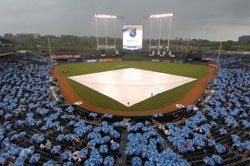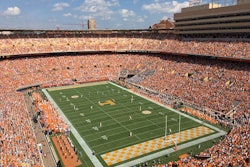In one of baseball's enduring scenes, drizzle turns into a steady rain, the home-plate umpire gives a signal and, as the spectators seek cover, the grounds crew looks for one of their own.
 ROYAL TREATMENT Keeping rain off infields, like the one at Kansas City's Kauffman Stadium, is just one of the tasks ably handled by field covers.
ROYAL TREATMENT Keeping rain off infields, like the one at Kansas City's Kauffman Stadium, is just one of the tasks ably handled by field covers.In one of baseball's enduring scenes, drizzle turns into a steady rain, the home-plate umpire gives a signal and, as the spectators seek cover, the grounds crew looks for one of their own. Pushing a huge roller from the edge of the stands, a dozen workers in slickers run onto the infield, pulling a tarp from the roller, and after just a few minutes of unfolding and dragging, they've protected the infield from the brunt of the inclement weather.
The rest of the cover story occurs away from the spotlight, but field owners are intimately familiar with it. Rain, snow and athletes' cleats can do a lot of damage to grass and skinned infields, and a relatively small investment in covers of various types can go a long way toward securing a much larger investment in the development and maintenance of sports surfaces.
The variety can surprise newcomers to the field of field maintenance. Allen Biddinger, assistant director of athletic facilities at Lehigh University, lays out a typical roster of covers: A home-plate tarp and mound tarp used after every practice or game to help protect these high-use clay areas, an infield tarp for when it rains, a mesh cover that protects that skinned area in front of home plate during batting practice, and a winter-growth cover that sits over the infield from November into early March. (Covers are also used during the season to keep moisture from evaporating out of clay surfaces.)
And that's just for baseball. The school's softball diamond gets similar treatment, while the football field is outfitted with game-day sideline covers, four covers used when heavy or extended periods of rain are in the forecast, and a winter-growth cover. The football field's rain covers sometimes cover the soccer field, as well, depending on the schedule of upcoming games, and several growth covers in the 20-yard-square to 30-yard-square range cover the soccer game field and soccer practice fields (particularly around goal mouths) through the winter.
Field covers tend to go unnoticed even when they're performing as intended, but Biddinger's crew noticed a marked improvement in the health of the baseball field's natural grass after two years of winter-growth-cover use. The university then made a major investment in covers after it installed an irrigation system and remade the surface at Goodman Stadium, Lehigh's home football field, in 2008. That refurbishment was the impetus to purchase the soccer fields' various growth covers, as well as a full-field growth tarp to protect the new football surface.
 TRAFFIC SIGN Sideline covers that protect against 50 sets of cleats can be customized with team names and colors.
TRAFFIC SIGN Sideline covers that protect against 50 sets of cleats can be customized with team names and colors.Field covers come in different weights and weaves, depending on their purpose. Winter covers, which are used to promote faster growth and springtime green-up, are made of a breathable fabric to allow water and air to pass through, whereas rain covers are fabricated to hold water so that it can be moved off the surface to the sideline once the covers are removed. Owners of grass fields ringed by tracks and field-event run-ups sometimes purchase covers in the latter category to protect these other surfaces from spike wear.
Tarps and covers can be purchased from a variety of sources, but one advantage to engaging the services of a cover specialist is having a single source for the various pieces of equipment that can make setup and takedown easier. Steel chain sewn into the perimeter help keep covers in place, while sewn-in grommets help accommodate wind stakes without compromising the cover fabric. Cover manufacturers also offer high-strength corrugated-metal or plastic rollers for storing covers, as well as trailer attachments that can aid in the movement of field cover rollers in the absence of the needed manpower.
St. Ambrose University works with a local fabricator, and Tony Huntley, the university's director of athletic facilities and associate head baseball coach, says he couldn't be happier with the results. As it happens, St. Ambrose barely has any grass to cover; the university plays its football at Brady Street Stadium (a city-owned synthetic turf field) and is responsible for just half the maintenance of Modern Woodman Park, the baseball diamond it shares with the Class-A Quad Cities River Bandits. Still, Huntley reports spending around $3,000 every three years to help pay for covers, including a mound cover, a home-plate cover, two bullpen tarps, several infield batting-practice protective covers and a full-field cover.
"We cover the mound, home plate and bullpen mounds every day, use the field tarp when needed, and the batting practice covers two to three times a week," Huntley says, adding that even with the harsh weather, he expects to get three to five years out of them. "You definitely get what you pay for with field covers, and using and storing them properly helps them last."
All that moving around of covers - not to mention all those ultraviolet rays and all that precipitation - means they have to be built to last. Biddinger, who also describes himself as a satisfied cover customer, nonetheless estimates that his department replaces smaller rain covers every year or two due to the repeated rolling and folding of the fabric. As a rule, the larger covers have withstood the elements. "We probably use the baseball and softball rain tarps anywhere from 10 to 20 times a year, and they've held up well," Biddinger says. "We've only seen the life expectancy drop on them as a result of mice burrowing into them over the winter months."




































